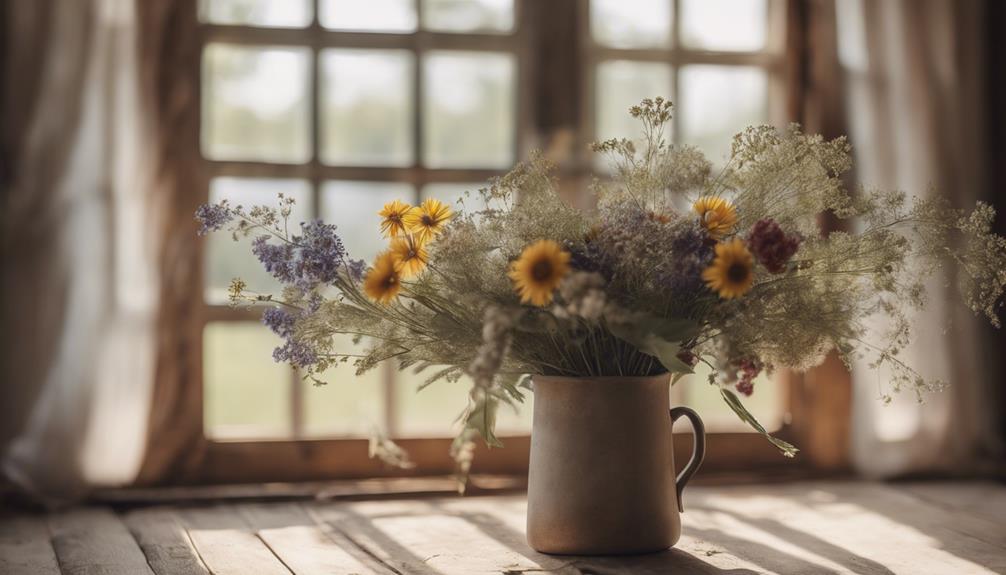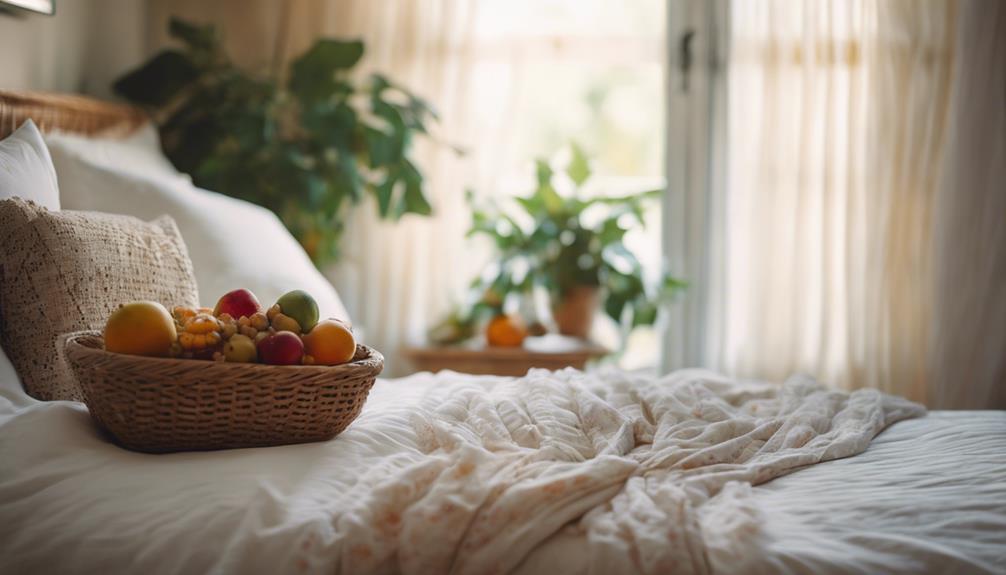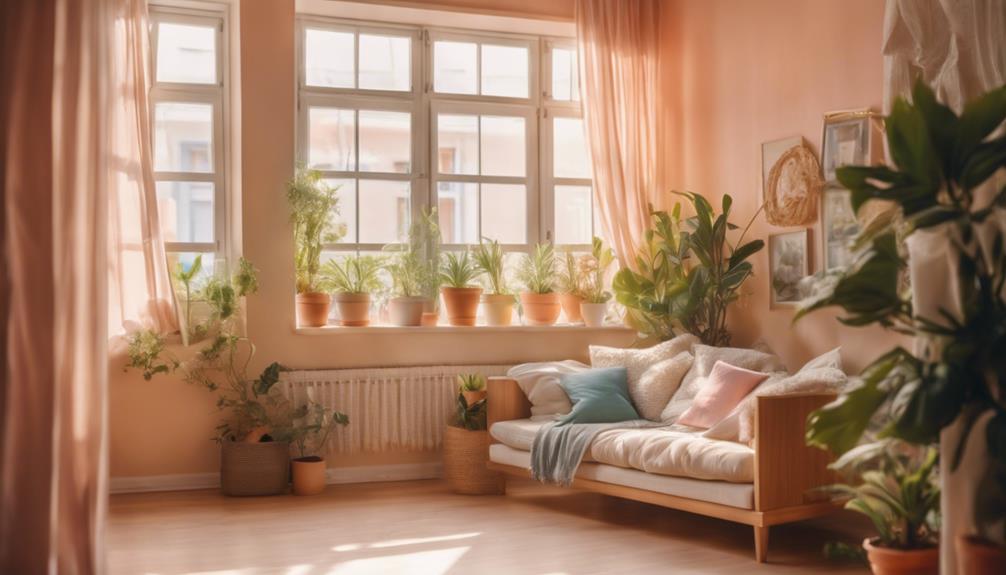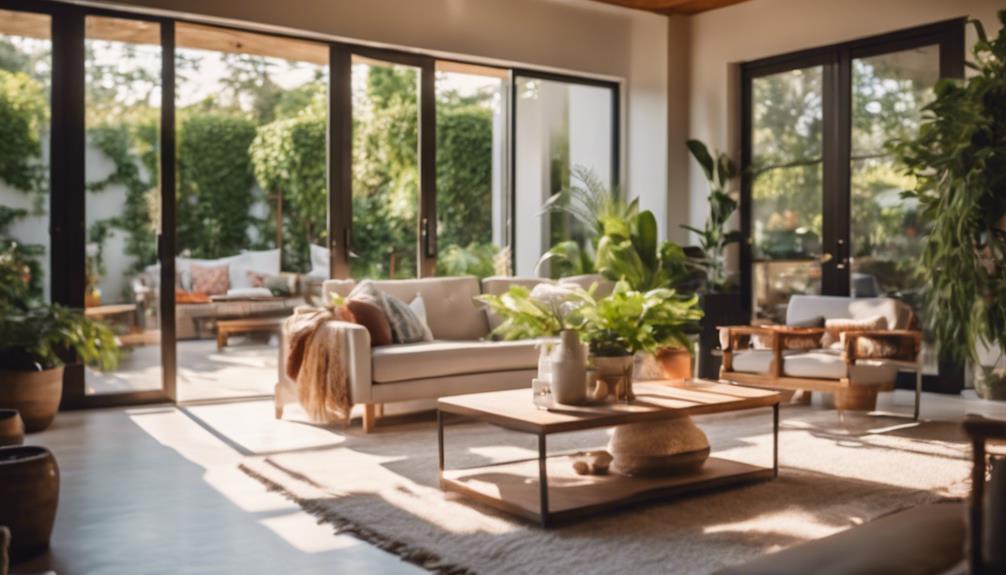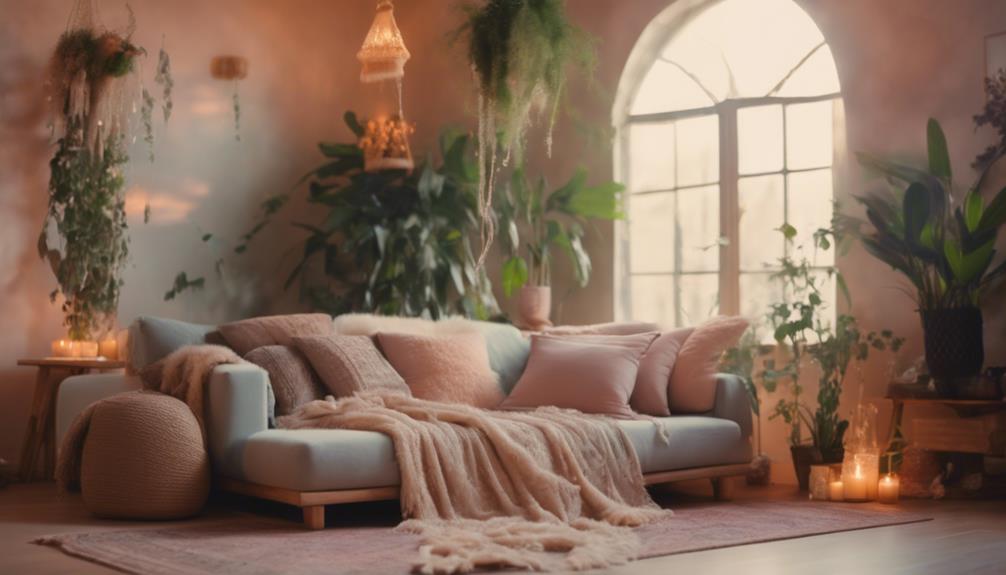In just two weeks, you can easily adopt a country style from your minimalist roots. Start by embracing earthy tones and natural materials like reclaimed wood and organic textiles. Incorporate key pieces like a rustic dining table and antique lighting to create focal points. Maximize natural light with large windows and add cozy textures through soft fabrics. Use simple decorative elements like dried lavender bundles and woven baskets to enhance warmth without clutter. With these adjustments, your space will shift from minimalist to invitingly rustic, and there are even more tips to explore for a seamless change.
Key Elements
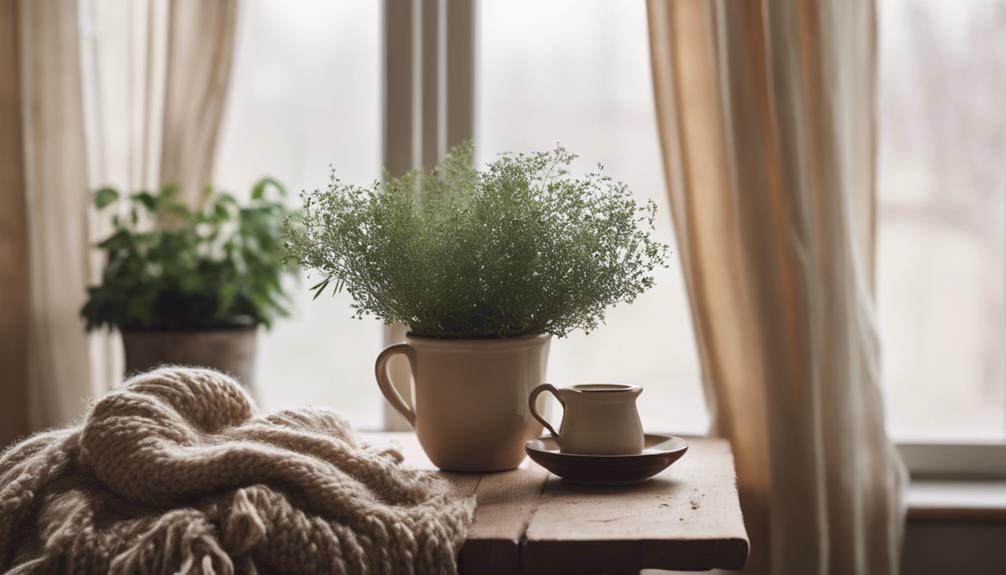
When you embrace a minimalist country style, the color scheme, materials, and textures become essential elements.
You'll find that earthy tones and natural materials create a welcoming vibe while keeping things simple.
This blend not only enhances the aesthetic but also promotes a sense of calm and connection to nature.
Color Scheme
A minimalist adopting country style should focus on a neutral color palette, favoring earthy tones that create a calming and cohesive environment. Think beige, taupe, and soft whites to establish a serene backdrop. This approach allows you to maintain a minimalist ethos while embracing the warmth of country aesthetics.
To add character without overwhelming your space, introduce accent colors like muted greens, soft blues, or rustic reds. These hues can highlight specific areas or features within your home, enhancing the overall color scheme without straying from simplicity.
Pay attention to textures as they play a significant role in your design. Opt for matte finishes and soft fabrics that harmonize with your chosen colors, fostering a cozy atmosphere that invites relaxation.
Materials
Incorporating the right materials is vital to achieving the harmonious blend of minimalist and country styles in your space. Start with natural materials, like reclaimed wood and organic textiles, to create warmth and character. These materials not only enhance the aesthetic but also align with sustainability principles, which are essential to both styles.
Choose multi-functional furniture that embodies simplicity and efficiency. A rustic dining table that doubles as a workspace keeps your space functional without overwhelming it. This approach guarantees that each piece serves a purpose while maintaining an inviting atmosphere.
When it comes to decorative items, less is more. Limit yourself to a few meaningful pieces that evoke nostalgia or joy. This focus reduces visual clutter, allowing you to enjoy the essence of each item without feeling overwhelmed. Consider adding unique artifacts or handcrafted items that reflect personal stories, further connecting you to the space.
Lastly, let in natural light and integrate greenery through large windows and indoor plants. This connection to nature amplifies the tranquility, blending the calmness of minimalism with the warmth of country style. With these materials, you'll create a cohesive and inviting environment.
Textures
Textures are essential for creating a cozy atmosphere in your minimalist adopted country style, adding depth and warmth without overwhelming your space. To achieve this balance, focus on natural materials like wood, linen, and cotton, which enhance your minimalist aesthetic.
Incorporating varied textures, such as woven baskets, soft rugs, and burlap accents, can create visual interest while maintaining a simple, uncluttered environment. Mix smooth surfaces, like polished wood furniture, with rougher textures, such as reclaimed barn wood or stone, to promote warmth and comfort.
Layering different textiles—think cozy throws and cushions—softens minimalist designs, making your home feel inviting and lived-in while still honoring the principle of intentionality. Strategically utilizing textures can also serve as focal points in your space.
Consider a feature wall with textured wallpaper or a statement piece like a chunky knit blanket. These elements draw attention without creating chaos, reinforcing the cozy vibe you desire. By thoughtfully integrating textures, you'll enrich your minimalist adopted country style, ensuring it remains both stylish and welcoming.
Essential Fixtures and Furniture
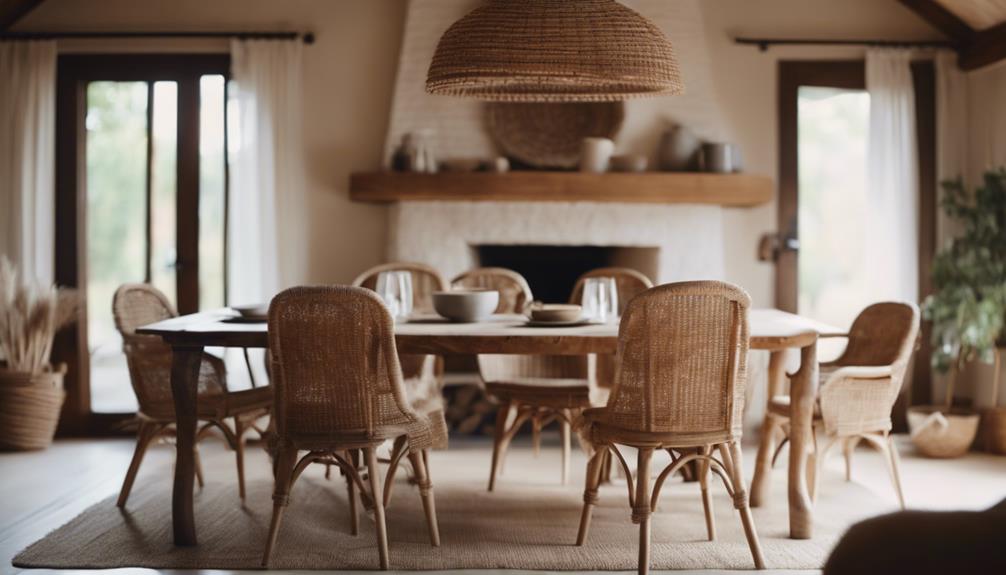
When choosing essential fixtures and furniture for your minimalist country style, focus on key pieces like a reclaimed wood dining table that serves multiple purposes.
Pair it with vintage metal wall sconces and antique brass pendant lights to enhance the rustic charm.
These elements not only create a cohesive look but also maintain the simplicity that defines your aesthetic.
Reclaimed Wood Dining Table
A reclaimed wood dining table not only serves as a striking centerpiece in your minimalist country-style home but also highlights sustainability and rustic charm. Sourced from old barns and factories, this table reduces the demand for new timber, making it an eco-friendly choice. Its durability guarantees that it withstands the test of time while developing a unique character and patina, adding warmth to your decor.
In a minimalist home, where simplicity and versatility are key, a reclaimed wood dining table can easily double as a workspace or gathering spot. This multifunctional piece allows you to maximize your space while promoting quality time with family and friends. The organic textures and colors of reclaimed wood foster a connection to nature, harmonizing beautifully with a serene, clutter-free environment.
When you choose a reclaimed wood dining table, you're not just selecting furniture; you're embracing a lifestyle that values sustainability and authenticity. This central piece not only enhances your home's aesthetic but also supports waste reduction and recycling, making it a responsible choice that reflects your commitment to both style and the planet.
Vintage Metal Wall Sconce
Incorporating vintage metal wall sconces into your minimalist country-style home adds both functional lighting and a touch of rustic charm, enhancing the overall aesthetic while keeping your space clutter-free.
These sconces not only illuminate your rooms but also serve as beautiful focal points, embracing the principles of minimalism through their intentional design and purpose. Often featuring distressed finishes and intricate designs, vintage metal wall sconces bring warmth to your interiors, perfectly complementing the cozy atmosphere typical of country-style decor.
You'll find that their versatility allows you to place them in various settings, from living rooms to hallways, without overwhelming your space.
Sourcing these fixtures from antique shops or flea markets not only adds unique character to your home but also supports sustainable living by repurposing materials. By choosing vintage metal wall sconces, you're making a conscious decision to reduce the demand for new manufacturing, aligning with the minimalist goal of thoughtful consumption.
Antique Brass Pendant Light
Antique brass pendant lights blend timeless elegance with rustic charm, enhancing the minimalist country-style aesthetic in your home. These fixtures serve not just as lighting but as focal points that elevate your space. The warm tones of antique brass create a cozy atmosphere, making your minimalist home feel inviting while keeping the design simple.
Intricate designs often found in antique brass pendant lights add character without overwhelming the setting. This aligns perfectly with the minimalist principle of intentionality in decor—each piece should serve a purpose and contribute to the overall look. When you incorporate these lights, you effectively illuminate key areas like dining or living spaces, promoting openness and clarity in your design.
When selecting your antique brass fixtures, consider their size and scale to guarantee they complement your minimalist aesthetic. Larger pendants can serve as statement pieces, while smaller ones can provide subtle accents.
Lighting Ideas

When it comes to lighting in a minimalist country style, you'll want to focus on creating a warm and inviting atmosphere.
Consider using soft Edison bulb fixtures and large windows to maximize natural light, while rustic lanterns can add a charming touch.
Handcrafted ceramic table lamps also provide functional beauty, enhancing the cozy vibe you're aiming for.
Soft Edison Bulb Fixtures
Soft Edison bulb fixtures lend a warm ambiance to your minimalist country-style home, making it feel inviting and cozy. These vintage-style bulbs are perfect for enhancing your cozy aesthetic while providing an energy-efficient lighting solution.
With their unique filament design, soft Edison bulbs not only offer the same brightness as traditional incandescent bulbs but also consume less energy, making them environmentally friendly.
You can easily integrate soft Edison bulb fixtures into various areas of your home, whether it's hanging a pendant light in the kitchen or installing sconces in the living room. Their versatile designs allow you to maintain a minimalist look while adding character to your decor.
Many of these fixtures also come with dimmable options, giving you the flexibility to adjust the lighting intensity to match your mood or occasion.
Natural Light Through Large Windows
To create a bright and inviting atmosphere in your minimalist country-style home, large windows play an essential role by flooding your space with natural light. These expansive windows maximize sunlight, making your interiors feel open and airy—a perfect match for the tranquility you seek.
When selecting windows, consider energy-efficient options to reduce costs while still allowing ample natural light to pour in.
Pair your large windows with sheer curtains or minimalist blinds to control light levels without disrupting the aesthetic. This way, you retain the beauty of natural light while enjoying privacy.
Strategically placing windows not only enhances the lighting but also frames stunning views of your natural surroundings, bringing the outdoors inside and fostering a deeper connection to nature.
If you're limited on wall space, don't forget about skylights. They can considerably boost natural light in areas that might otherwise feel dark, ensuring that every corner of your home remains welcoming and bright.
Rustic Lanterns for Ambient Lighting
Rustic lanterns bring a warm and inviting ambiance to your minimalist country-style home, enhancing both the aesthetic and functionality of your space. These versatile lighting options, crafted from wood, metal, or glass, can beautifully complement your decor while providing essential ambient lighting. You can choose lanterns powered by candles, LED lights, or even solar energy, allowing you to reduce reliance on traditional electrical sources.
To create a visually appealing atmosphere, group rustic lanterns of varying heights and styles on tables, mantels, or even hang them from ceilings. This adds depth and interest, making your space feel cozy and inviting. Not only are they perfect for indoors, but they also shine outdoors, illuminating pathways, patios, or dining areas, seamlessly blending utility and charm.
To further embrace the country aesthetic, consider incorporating natural elements like twine, burlap, or floral arrangements with your lanterns. This purposeful curation aligns perfectly with minimalism, ensuring that each piece serves a function while contributing to the overall beauty of your home.
With rustic lanterns, you'll effortlessly create a warm, inviting environment that reflects your unique style.
Handcrafted Ceramic Table Lamps
Handcrafted ceramic table lamps bring a unique artistic flair to your minimalist country-style home, merging functionality with eye-catching design. These lamps serve as striking focal points, elevating your space while maintaining a sense of simplicity.
When you're selecting ceramic table lamps, look for those in earthy tones or natural glazes that resonate with the rustic aesthetic of country design. Many artisans now offer customizable options, allowing you to choose the size, shape, and finish to perfectly align with your minimalist decor needs.
Incorporating just a few statement ceramic lamps can create a serene atmosphere, avoiding the clutter that comes with numerous smaller lighting sources. This approach not only enhances your living space but also aligns with minimalist principles.
Moreover, consider using energy-efficient LED bulbs in your handcrafted ceramic table lamps. This choice boosts sustainability and helps reduce energy consumption, further supporting your minimalist lifestyle.
For more inspiration, check out a minimalist blog that showcases how these lamps can seamlessly blend art and utility in your home. Embrace the blend of craftsmanship and practicality to illuminate your space beautifully.
Decorative Elements
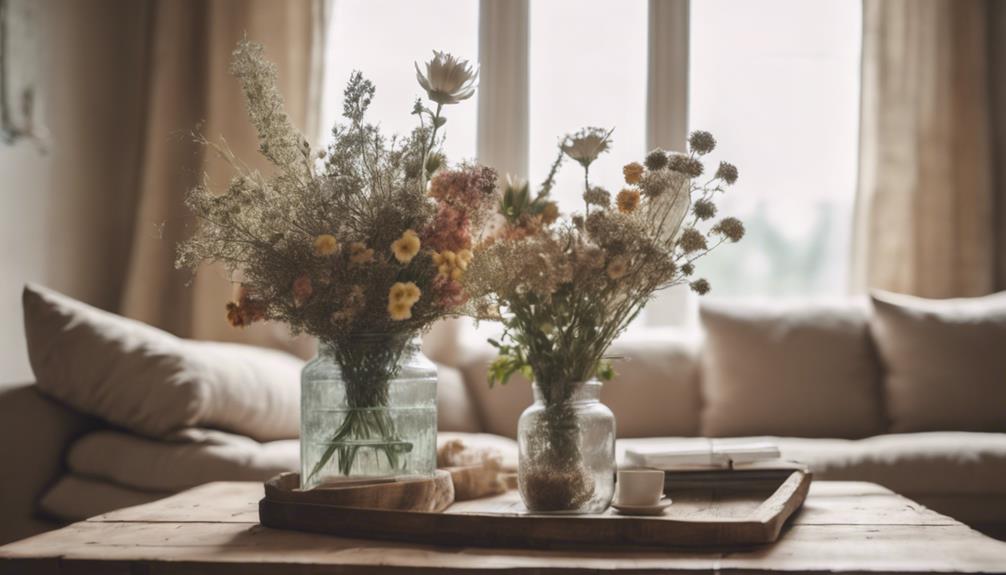
When it comes to decorative elements, you can create a stunning country vibe without cluttering your space.
Consider using a woven wicker basket as a centerpiece, a hand-painted ceramic vase for a pop of color, or dried lavender bundles to bring in a touch of nature.
These simple additions enhance your minimalist aesthetic while still embracing the warmth of country style. For example, adding a few rustic wooden shelves to your kitchen can provide both functionality and a touch of natural beauty. Pairing these shelves with sleek, black metal hardware and clean, white subway tiles can create a modern country kitchen style that feels both cozy and contemporary. Incorporating these elements into your space will allow you to enjoy the best of both worlds – minimalist design and the charm of a modern country kitchen style.
Woven Wicker Basket Centerpiece
Woven wicker baskets add a touch of warmth and texture to your minimalist home, making them perfect for creating inviting centerpiece arrangements. These versatile decorative elements come in various sizes and shapes, allowing you to get creative with how you display them on tables or shelves. A well-placed wicker basket not only enhances your aesthetic but also serves practical purposes.
By incorporating a wicker basket centerpiece, you can organize items like fruits, magazines, or blankets, promoting a clutter-free environment. This functionality aligns perfectly with minimalist values, as it helps maintain simplicity while adding character to your space. Plus, wicker is a sustainable material, often made from natural fibers, making it an eco-friendly choice.
When selecting your basket, opt for simple, neutral colors to enhance the minimalist design. This way, your wicker basket can seamlessly blend with other decor elements without overwhelming your space. With just a few thoughtfully arranged woven wicker baskets, you can transform your home into a cozy retreat that reflects your newfound country style, all while keeping it effortlessly stylish and organized.
Hand-Painted Ceramic Vase
Hand-painted ceramic vases bring a splash of color and artistry to your minimalist country style home, enhancing both its functionality and aesthetic appeal. These vases are often characterized by unique designs and vibrant colors, making them ideal decorative elements for your space. They serve dual purposes, acting as beautiful containers for fresh flowers while also standing out as artistic focal points.
When selecting hand-painted ceramic vases, focus on those that feature natural motifs or earthy tones. These choices will complement the rustic charm inherent in country style decor, creating a cohesive look. You don't need a multitude; a few well-placed vases can introduce visual interest and warmth without overwhelming the principles of simplicity and intentionality that define minimalist country style.
Moreover, many of these vases are crafted by local artisans, supporting sustainable practices and adding a personal touch to your home. By incorporating hand-painted ceramic vases into your decor, you'll achieve a delightful balance between artistic expression and minimalist elegance.
Embrace this decorative element to transform your space into a warm, inviting haven.
Dried Lavender Bundles Display
Dried lavender bundles add a charming touch to your minimalist country style, bringing both beauty and tranquility to your space. By incorporating these delightful bundles, you embrace minimalism while enhancing your home's aesthetic. Their natural purple hue offers a subtle pop of color, perfectly aligning with your intention to keep things simple and serene.
You can display dried lavender bundles in various ways. Hang them in bunches from hooks or beams to create a rustic focal point, or place them in small vases around your home for an inviting ambiance. Not only do they provide visual appeal, but they also infuse your space with a calming fragrance, promoting relaxation. Plus, dried lavender acts as a natural pest repellent, adding practicality to its charm.
Embracing dried lavender bundles is also cost-effective. Whether you source them from local farms or grow them at home, this approach promotes sustainability while maintaining your minimalist principles. By integrating these beautiful and functional elements, you'll cultivate a home that radiates warmth and tranquility, effortlessly blending minimalist design with country charm.
Flooring
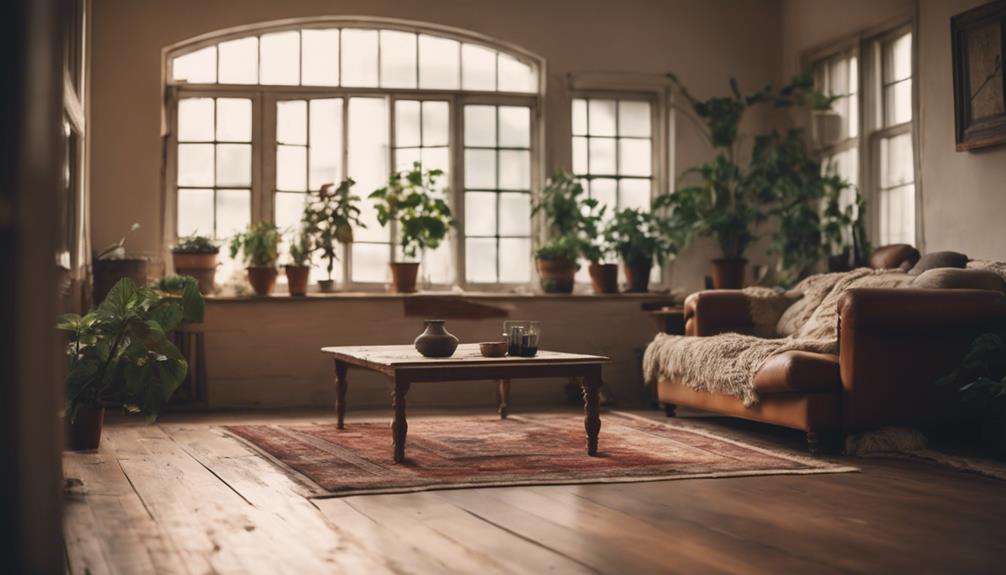
When it comes to flooring in your minimalist country home, you've got some great options.
Reclaimed barn wood planks offer a warm, rustic feel, while cottage-style patterned tile can add a charming touch.
Natural stone flagstone tiles also bring a unique character, blending durability with a cozy aesthetic.
Reclaimed Barn Wood Planks
Reclaimed barn wood planks offer a sustainable and stylish flooring option that brings unique character and history into your home. Sourced from old barns and buildings, these planks reduce the demand for new timber, helping to preserve our natural resources.
In a smaller home, they add rustic charm with their variety of textures, colors, and historical markings, making each space feel warm and inviting.
Beyond aesthetics, reclaimed barn wood flooring enhances insulation and acoustics, creating a cozier environment. You'll appreciate how it absorbs sound, making your home quieter and more peaceful.
Opting for this flooring can notably lower your carbon footprint, as it recycles materials instead of contributing to deforestation.
With proper treatment and finishing, reclaimed barn wood planks are durable enough to last for generations. This durability means you're investing in long-term value while enjoying the beauty and uniqueness that only reclaimed wood can provide.
Cottage-Style Patterned Tile
Cottage-style patterned tile flooring brings a touch of warmth and charm to your minimalist space, featuring intricate designs that invite creativity and personality. With vibrant colors and vintage patterns, these tiles evoke the cozy atmosphere of country homes, making them an ideal choice for enhancing your home's aesthetic.
Durable materials like ceramic or porcelain guarantee that this flooring not only looks great but also stands up to high-traffic areas in your home. You'll appreciate how the repetitive designs can visually expand your room, creating a sense of flow and continuity that complements your simple living philosophy.
Moreover, choosing cottage-style patterned tile means you'll benefit from easy cleaning and maintenance, perfect for busy families or individuals focused on functionality. The floral motifs or geometric shapes add a rustic charm that resonates with your minimalist approach while allowing you to express your personality.
Incorporating cottage-style patterned tile into your flooring is a straightforward way to blend country charm with minimalist design, making it a practical yet stylish choice for your home.
Embrace the warmth and character these tiles bring to your living space!
Natural Stone Flagstone Tiles
Natural stone flagstone tiles offer a unique blend of durability and rustic charm, making them perfect for enhancing the beauty of both indoor and outdoor spaces. These tiles come in various stones like slate, limestone, and sandstone, ensuring you find the right fit for your country-style home. Their irregular shapes and sizes create customized patterns, adding a distinctive touch to your flooring.
You'll appreciate the natural slip resistance of flagstone, making it a safe option for areas prone to moisture, such as entryways and patios. Installing these tiles using a dry-laid method allows for flexibility in design and effective drainage, contributing to that organic look you desire.
To maintain the beauty and longevity of your natural stone flagstone tiles, proper sealing and maintenance are essential. This prevents stains and weathering, keeping them looking fresh.
You can even add an area rug over the flagstone to create a cozy, inviting atmosphere while still enjoying the flooring's natural appeal. With these tiles, you're not just choosing a flooring option; you're enhancing your home's rustic charm effortlessly.
Conclusion
In just two weeks, you can transform your space from minimalist to cozy country style by focusing on essential fixtures and furniture.
Choose warm lighting to create an inviting atmosphere, and incorporate decorative elements that reflect nature.
Don't forget about the flooring—natural wood or rustic tiles can tie everything together beautifully.
Embrace this new aesthetic, and you'll find your home feels more welcoming and comfortable, perfect for relaxing or entertaining friends and family.
